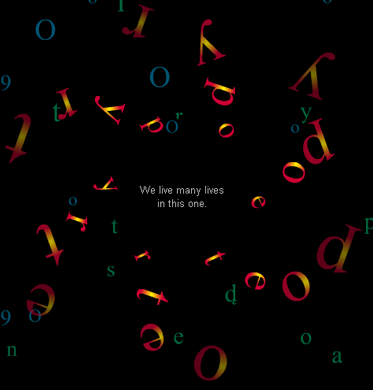G A M E S , P O , A R T, P L A Y, & A R T E R O I D S 2.03
Jim Andrews, August 2002 (updated May 2005)
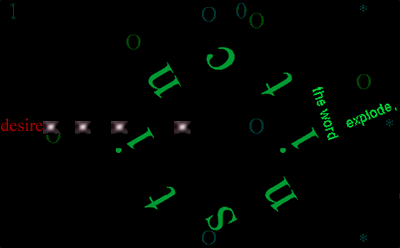
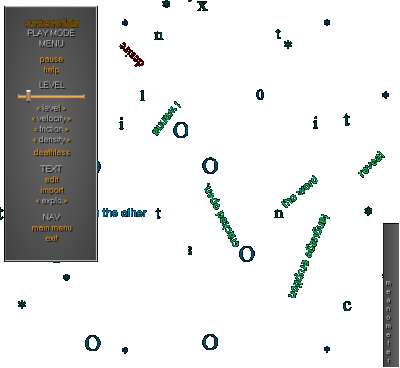
the Play Mode Menu
THE BATTLE OF POETRY
AGAINST ITSELF AND THE FORCES
OF DULLNESS
Arteroids makes poetry suffer in heretofore unsuspected ways. We are aware both of the poetry of suffering and the suffering of poetry.
Arteroids is not the most probable venue for poetry of suffering but, in game mode, poetry itself does do battle with the forces of dullness and its fate is up to you.
The player drives their red red id entity text around the screen using the keyboard, and executes texts via the id entity gun, or is blown up by green and blue marauding, vociferous texts.
Kind of an 'end of language' piece. Yet only the small death, for the most part: the id entity and the executed texts are resurrected as per usual in computer games after the player succumbs to the mortal distress of texts with legs and eyes. And as much is created as destroyed in the language wars between sense and strong, dynamic language.
In Game Mode, the player captains their beleagered "poetry" ship as red red id entity text against the green text, which is the forces of dullness incarnate, and the blue text, which spells out a different message. The blue and the green texts of imaginative destruction explode, are cracked open like words vaporized into ideas, when the player shoots them. Their explosions are circular lettristic sprays of letters,
Arteroids is about cracking language open. William S. Burroughs said about audio tape that when you cut it, the future spills out. When writers and artists use cut-up techniques of all kinds on all types of media, when sound is an inscribable, editable object just as language is—and the same goes for video and other digitizable material information—then language is indeed cracked open in the sense that the fundamental symbols of writing are no longer simply the letters in the alphabet and other typographical marks. Writing is now a larger thing.
Part of what Burroughs may have meant is that when you cut audio tape, you discover that sound is now object, and very strange object at that, but clearly the analog razor blade and now the digitally precise, desktop studios of digital audio deal with sound like Word deals with words, in many ways—as fundamental symbol and combinatorially concatenated string of 'letters' and signification, pattern, design, extended composition in space and time to cognize.
We edit the properties of such objects in much the same ways, whether they are images, texts, sounds, videos, applications, etc; all but sounds can be 'visible' or 'invisible', for instance but, more importantly, they are all material objects of information that have editable properties and perhaps even methods or handlers at their disposal. Ah yes, well if they have their methods, they are also animistic and slightly marauding entities that have spilled from the future of cutting audio tape and other such acts of media object creation.
The future and the present
are involved in the emergence of new media language that multiplies the
symbols of writing, and changes writing from dealing with solely typographical
material to multimedia composition and cognizing.
language exfoliation/explosion
THE AUDIO
Now that you're reading, let me point out that there is a working copy of Arteroids embedded in this essay toward the bottom. If the page is fully loaded, you can hear the audio in this essay, play the game, even, in this essay. Though fullscreen is funner, at least for higher levels, and performance inside this page, with all the other graphics and animations, may be slower than fullscreen.
But I thought it would be interesting to have the subject in the object of the essay. It should eliminate some writing on my part.
The sounds of exploding arteroidal texts are male, female, young and old, human and semi-human, semi-human and animal. Every sound in Arteroids is my voice and nothing but--with a little help from Sound Forge. The sounds range from cartoonish to adult, sound poetry to computer game, Kurt Schwitters to Mel Blanc and Gregory Whitehead in their associations.
When the player executes a text, one of 21 sounds is selected. A random pitch-change is then made to the sound anywhere between ten semitones above the original pitch and 20 semitones below the original pitch. It is the pitch-change that gives Arteroids its sonic range into the animal and semi-human, the female, and the child, primarily. Pitch-change also provides greater variety with 21 petit death sounds, so that the sound is suitably rich in variety.
As you can hear in the MP3's linked to the Arteroids home page, sound recordings I made of games I played, the audio, when the game is played well, is listenable in its own right as a kind of sound poetry punctuated into different 'verses' between the explosion of poetry.
Part of the idea of the audio
is to create a high energy sound track for a game, and make it ultra human,
or hyperhuman, as the case may be. Really alive, in any case, and lively.
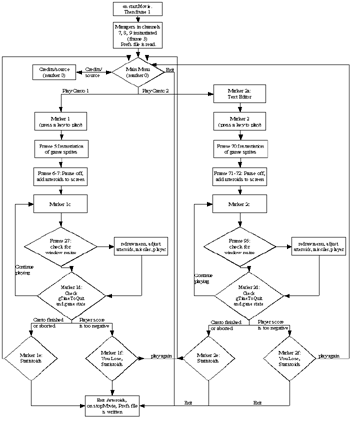
old and distressed
Arteroids flowchart
Arteroids aspires
to the gems
on the other side of the
shoot-em-up.
Past
twitch, past
militarism, past
nationalistic terror
and juvenile initiation
in becoming a warrior.
though
it can be
about
these
things.
MILITARISM AND VIOLENCE IN COMPUTER GAMES
Before the sound went into Arteroids (version 1.0 has no sound), it felt destructive to shoot up the texts. Now that the sound is in, it motivates a different attitude toward the shooting aspect of Arteroids. I don't like guns, and I do not want to essentially advocate violence or thoughtless destruction. Lord knows there's enough of it in the world, but also in computer games, which revel in being as gratuitous as can be.
In any case, with the sound in, it is clear that when you execute a text, you trigger one of the more pleasurable experiences of the piece, and something you hopefully feel inclined to explore. So that the shooting becomes, hopefully, an act of curiosity and composition. Part of what I am trying to do over several versions of the piece is move from 'shoot-em-up' to something every bit as interesting but different from shooting a gun.
Militarism in computer games is different from violence in computer games. Militarism in computer games is sometimes to train little boys to be good little war pigs, ie, shoot first, ask questions later, or good little consumers, or the games are made by not war pigs but apathetic war pigs who would rather make computer games. Couch potato war pigs.
Violence in computer games is sometimes a dramatic representation, as it is in books, films, plays (quite a bit of gore in King Lear, for example) of meaningful conflict in which the forces of good and evil—and maybe even some shades of gray—engage in their process of realization and resolution.
Mostly, however, what we encounter are situations where there is no such meaning to the conflict but, instead, the player is in a constant act-or-die state of concentration on survival.
OPENING A FEELING-STREAM
Two people have said to me that computer games should be capable of scaring people. I interpret it to include the following possibility. It isn't so much that you want to scare people like in a horror movie, with gore. You want, however, to get their blood going. To startle them and challenge them and make them ever so slightly afraid for their 'lives'. And their 'life' should, in part, be felt to be involved or immersed in the game world. Immersed in the sense that it does indeed get their blood pumping. The id entity should hold some identification for them, and its travails should be of personal consequence and significance to the player.
It helps to be in kinaesthetic touch with the player. If you are in touch with the player kinaesthetically, you have a feeling stream open through which you can pump adrenaline and delight through the fingertips via the dance of the hand across the keys. What is under the player's fingertips can be like a vehicle or a gun or a musical instrument or an email client or any number of other things that we experience via the keyboard.
There are enough guns in enough real hands, and enough computer game guns that the making of guns in computer games must attain the next level of message passing as the real structural nexus of the activity of programming 'first or second person shooter games', ie, it isn't really the gun that is the most strongly dynamic and appealing element (though guns are primal and it becomes an imaginary life and death situation), it is the real-time/game-time control over the activity of interaction with objects that you pass messages to kinaesthetically via the keyboard, plus primal drama. If you don't have kinaesthetic control over a game in which you are supposed to have kinaesthetic control, do you play it? How about if it doesn't have sound? Would you play it still? Perhaps. But if the kinaesthetics are off, it's time to reboot or call it quits, isn't it?
Even in computer games we are faced with the problem of guns. One desires primality in art, and excitement. Guns are primally dramatic. They aren't going away. Yet while they are not going away and have a legitimate role in art, guns in computer games are starting to be minor variations of one another, ie, boring.
The games that will emerge that are the Web's own games (not tired retreads) will take advantage of message passing figuratively and literally, to fuller playful communications between people, and between people and media objects.
And between media objects.
But that's another story, a programming issue.
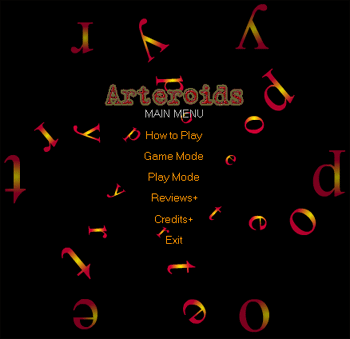
choose your poison
GAME MODE AND PLAY MODE
In Game Mode, you have but one life to live, and the goal is to max out the meanometer. When you eventually expire, perhaps after completing several levels, a death notice is issued (one of 200 different remarks), and you can play again. The death notices are a mixture of tips and development of the questions Arteroids asks. Player scores are also saved in Game Mode. Game mode is competitive.
However, Arteroids has a Play Mode, different in certain ways from Game Mode. Part of the idea of Arteroids is to explore the relations of game and play. Play is a crucial factor, also, in considering the relations between art and game. In Play Mode, the player has much more control over the configuration of Arteroids, and plays as long as the meanometer is not empty.
In Game Mode, you compete,
and we do not generally get to set as many options when we compete as
when we play. In Game Mode, you can play any level up to the level
you have attained in that game, whereas in Play Mode, you can play
any level at all.
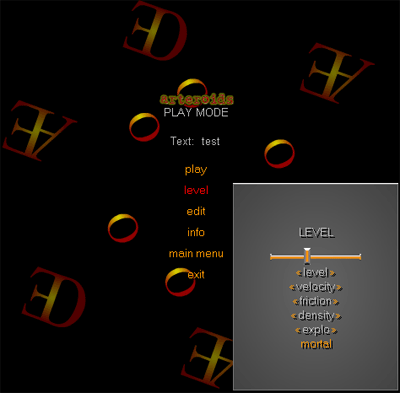
editing the Play Mode level;
there are
12*20*14=3360
settings of
velocity, friction, and density
in Play Mode,
but there are only
12*3*6=216
levels in Game Mode
so that progress
between levels
in Game Mode
is discernable.
THE VELOCITY AND KINAESTHETICS OF MEANING
In Play Mode, the player can set many options. The player can adjust the "velocity" of the attacking arteroidal texts, for instance (1-12). They can also set the "density" of the attacking texts (1-14). The higher the density of the texts, the more of them are arrayed against the player. You can also be "mortal" or "deathless"; when you are mortal, the arteroids kill the id entity on collision; when you are "deathless", then the arteroids do not cause you to explode.
Consequently, if you go "deathless" (click "mortal" to toggle to "deathless") and adjust the velocity and density appropriately, you can create a vispo display machine, ie, at suitably low velocity, the texts are readable. And if you drive the id entity around, the blue texts follow the id entity and the green texts maraud. This way, the piece is 'literary' in the sense that it is readable, and a presentation of the destruction of readable green and blue texts is possible. Or some other drama.
However, at high velocity, the texts become more or less unreadable except in flashing perceptions, which can be strong, and if you are "mortal" at high velocity, Arteroids moves quickly into the realm of the computer game versus the slower vispo readerly mode. It is interesting to observe how velocity and density work this transformation in the 'meaning' of the piece.
In Play Mode, the player can also adjust the fictive "friction". This determines how fast the id entity stops moving when you take your hands off the keyboard. As you adjust the fictive "friction," you can feel the change in how the id entity drives, like different cars have different feels concerning how they drive. And, as in a car, this is something that only the driver feels. This notion of the 'feel' of driving the id entity is part of the mindbody play of Arteroids. The thing involves the player as driver. We drive computers already.
FORMS OF PLAY AND SOFTWARE ART
There are various forms of play in Arteroids. Mindbody play, word play, game play, art play, poetry play, sound play, and communiplay. There are examples above of all but communiplay. A word about communiplay later.
The Augustart show features Arteroids 2.02, which launches here at Augustart. Version 2.02 represents 8 more months of full-time work on Arteroids 1.0. Arteroids is a piece of software art. Version 1.0 was published in issue 11 of theremediproject.com out of San Francisco, edited by Josh Ulm, in December 2001. It was published after having worked more or less full-time on it for seven months, with a Senior grant from the Canada Council.
However, in software art, what happens is that a piece of work goes through several development phases, each of which results in a 'finished' work, just like Word 1 was 'finished': it was functional and a complete thing unto itself, anyway, but was fated obviously for further development. That's the way Arteroids 1.0 was.
Nobody really cares about the differences between Word 9 and Word 10,
do they? But the differences between Word 1-5 were of interest. The degree
of difference between successive versions of software is most dramatic
in the first few versions. Hence, a work of software art will tend to
have the number of dev phases that result in dramatic difference between
versions. If the differences are not dramatic, the dev drama is over and
the project should probably be put to bed.
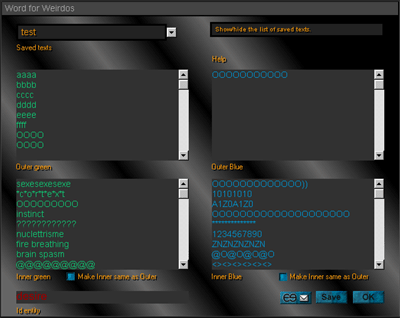
Word For Weirdos
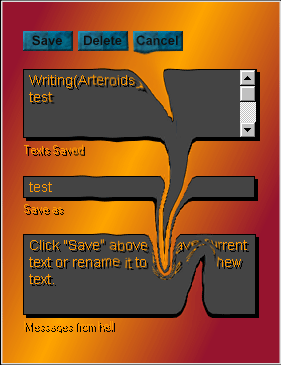
Saving texts in
Word for Weirdos
(on very bad day)
WORD FOR WEIRDOS
In Play Mode, players can use Word For Weirdos to create and save texts. They can then save poetry from themselves by having it out with the texts (unless the texts do away with the player). The id entity also is editable.
Word For Weirdos encapsulates an odd literary form. The wreader (writer/reader) creates an "outer green" text, an "inner green" text, an "outer blue" text, an "inner blue" text, an "id entity" text, and names the creation (or uses the default text) in Play Mode. The "outer green" text is the green text you see on screen when playing. The "inner green" text is the text into which the elements of the "outer green" text explode. These can be the same as the outer green or not, as you please. Arteroids saves these texts to disk for future recall, though it is a piece that runs over the Net.
Part of the idea of Arteroids is to explore the dynamics of this odd literary form. Basically, it's the id entity against the blue and green texts. What should the id entity be? What should the green text be, and the blue text? Various conflicts come to mind.
The question arises, though: "Does it matter?". In Game Mode and Play Mode at high velocity, the texts are not consciously readable. True, but they are in both Game Mode and Play Mode at low velocity and low density, which the player can set in Play Mode. And they are readable and editable in Word For Weirdos.
Also, it will matter that the texts be readable to those interested in poetry and digital art, because, really, it is a question concerning the degree to which Arteroids is involved in poetry, not simply kinetic language, if that is a valid distinction—certainly it's one that a lot of wired poets make.
Some writers must experience the evaporation of readability attendant upon velocity increase as a negation of readable language and of poetry itself. To me, however, it is as though there were also sliders for "readability", "game", and "play". When you change the velocity, you change these conceptual sliders, as it were.
Part of the idea of Arteroids is to investigate the slide of game, play, and art into one another. When is a game art? When does a game impose a competitive emphasis that rules out certain types of play? If the text becomes unreadable, it rules out certain types of play that are simply a part of reading. But, also, when the text becomes unreadable, it makes for a better game, if you like playing the game.
Arteroids shifts the focus between game and play, between text as readable literary object that gets its primary meaning from the meaning of the words to text as meaning via sound, motion, and destructive intent. When does "poetry" mean poetry, and when does it mean arteroid? It is a question of velocity, density, and other such concerns of visual (even multimedia) rhetoric, of emphasis and intent. This slides around in Arteroids.
What are the possible roles of language in dynamic multimedia work for the Web? Can poetry go here and live? Well, judge for yourself.
My own feeling is that a synthesis of media and arts,
including text, along with things like programming and its domain of art
such as computer games, changes them all in certain ways, limits them
and expands them in ways that are challenging and generative of new media
language.
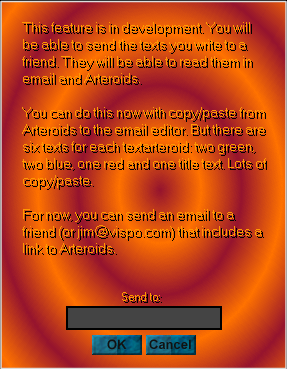
possible now but too much
work, and little community
save the good
and true
demented
few.
There is nothing
inherantly shoot-em-up
about the code of a shoot-em-up.
Instead, in reading the code, we
find that it is about message
passing between
objects,
collision detection,
and writing these objects
and their handlers (methods)
at
lowest
computational
complexity +
solid
OOP
architecture.
If the code
of shoot-em-ups
is about message
passing, among other
things, then why not
enable
message passing
between people
themselves?
This is
part of art,
game,
and play.
We learn
best
from others,
not machines,
and we play best
with others, not machines.
FUTURE DEV CYCLES
The idea is to make 5 versions of Arteroids, each a complete thing unto itself like Arteroids 2.02 is.
Version 3.0 will introduce communiplay. It will allow players to email one another texteroids. When you email me a texteroid you created in Arteroids, I read your texts in the email, and I can also click a link in the email. That link opens up Arteroids and sucks the texteroid into Word For Weirdos where you can save/edit it and gun it down in Play Mode.
You will also be able to download texts by 'our famous writers' and have at them.
I'm thinking also about creating an email list that you can sign up for. Only Word For Weirdos is the editor for the emails sent to the group. So, if you signed up for the list, you'd get an email from Sally, say, sent to the group, not just you. The text is read in the email. But to reply to the message, you click the link in the email, open Arteroids and Word For Weirdos, reply in the form of a texteroid, and mail it off to the group from Word For Weirdos.
This combines web.art and code.poetry (or whatever) in its concern with net mail communications. It is also a self-enabling 'publicity machine.' It is not 'viral' in the sense that it does not spam or self-replicate without the user's desire that it perform its email functions. But it is a 'publicity machine' in that people can email one another using Arteroids in ways that will hopefully be engaging and interesting to participate in, so that people will send one another messages using it and thereby publicize Arteroids.
Good ideas on the Net propagate by individual choice, not by viral exploitation. This concerns art and publicity. Some artists make much of the viral possibilities of the Net. I think that is a mistake. It's about communication, participation, and empowering, not uni-directional publicization and posturing for a fictive fame machine.
Version 3.0 will also let you see, in Game Mode, high scores over the Net and let you thereby see how you are doing competitively among others. Version 2.02 saves Game Mode scores to disk, like it saves texteroids to disk, but it does not send any of that info to a server.
In Game Mode, you compete against the machine and others (via their scores, in version 3.0). And score information is exchanged via communiplay. In Play Mode, you do not compete but play in many ways mentioned above, and writerly information is stored and communicated between people. Such is the exploration in Arteroids of (game, art), (game, play), (game, composition), (game, communication), and also things like (mindbody play, meaning), (velocity, meaning), (density, meaning) and other such pairs.
Version 5.0 of Arteroids will be multi-player, ie, you will be able to play somebody a game of Arteroids over the Net.
SYNTHESIS OF ARTS, MEDIA, AND PROGRAMMING
Arteroids combines written, visual, and sound poetry, visual art, computer game conventions, generative audio forms, and will soon also combine those with net communications. Part of the idea is to steer poetry and desire in dangerous directions. For myself, those directions involve synthesis of arts and media. I started out as a writer and radio producer. Then I moved into computers, and spent years learning how to program and do visual work. So now I try to combine them all together to show what is possible in digital art.
If 'multiple media' means several media together but not strongly related,
then 'multimedia' means several media together related strongly. Strength
comes in many forms, and thereby new media language is generated. We all
face the question of how to communicate strongly in new media. As producers
of communications in new media, we are constantly faced with this question.
We understand what the tools at hand are, but not always what to do with
them, how to use them effectively. What I have tried to do is understand
those tools and the possibility and nature of communications as deeply
as I have been able to do, and incarnate that understanding and feeling
in pieces such as Arteroids. I am excited about the possibilities for
synthesis of arts, media, and programming. The danger lies in robotic
work of the nullmind, mistaking technology for art, and substituting flash
and visual rhetoric for humanity. I have tried to make Arteroids a very
human literary machine of depth and consequence to thinking, feeling people
curious about the possibilities of digital poetry and art. I have also
tried to make it fun for kids used to computer games with good kinaesthetics
THE GAME ITSELF:
For a vastier experience, launch it fullscreen.
Lights out! Sound up! Throw away your preconceptions about poetry!
